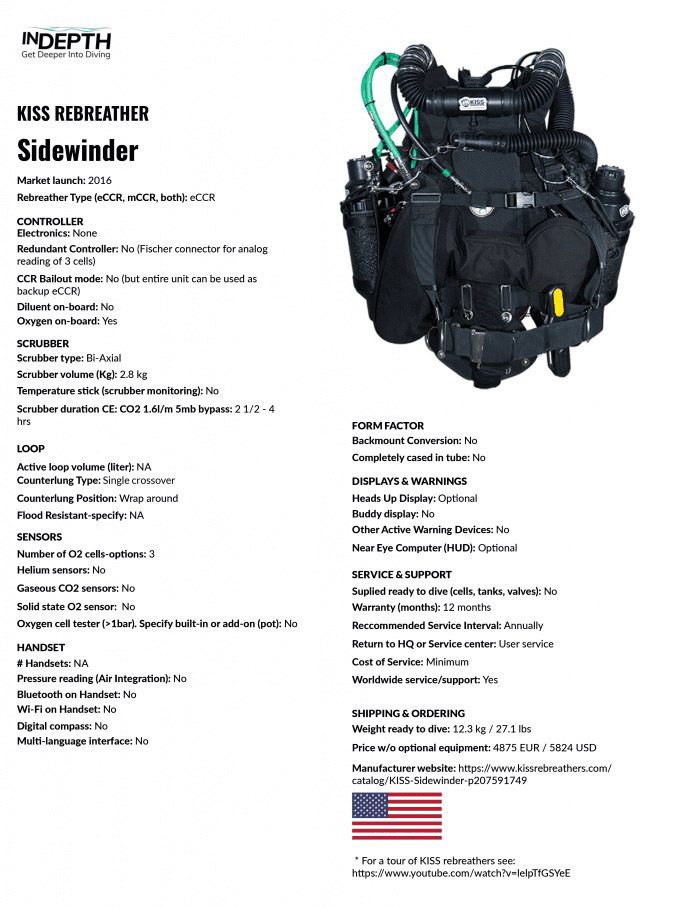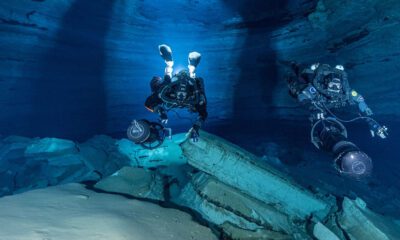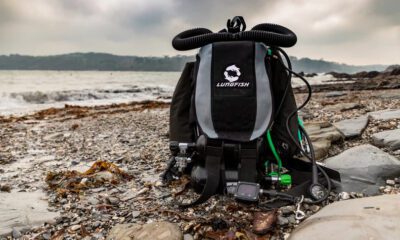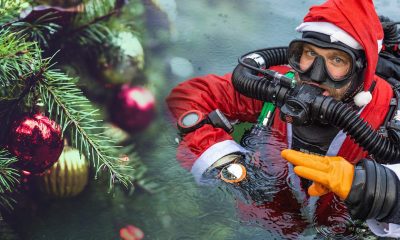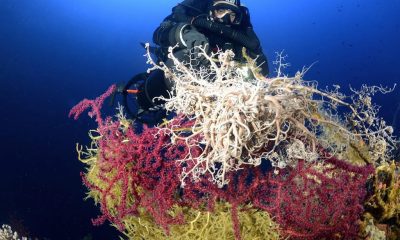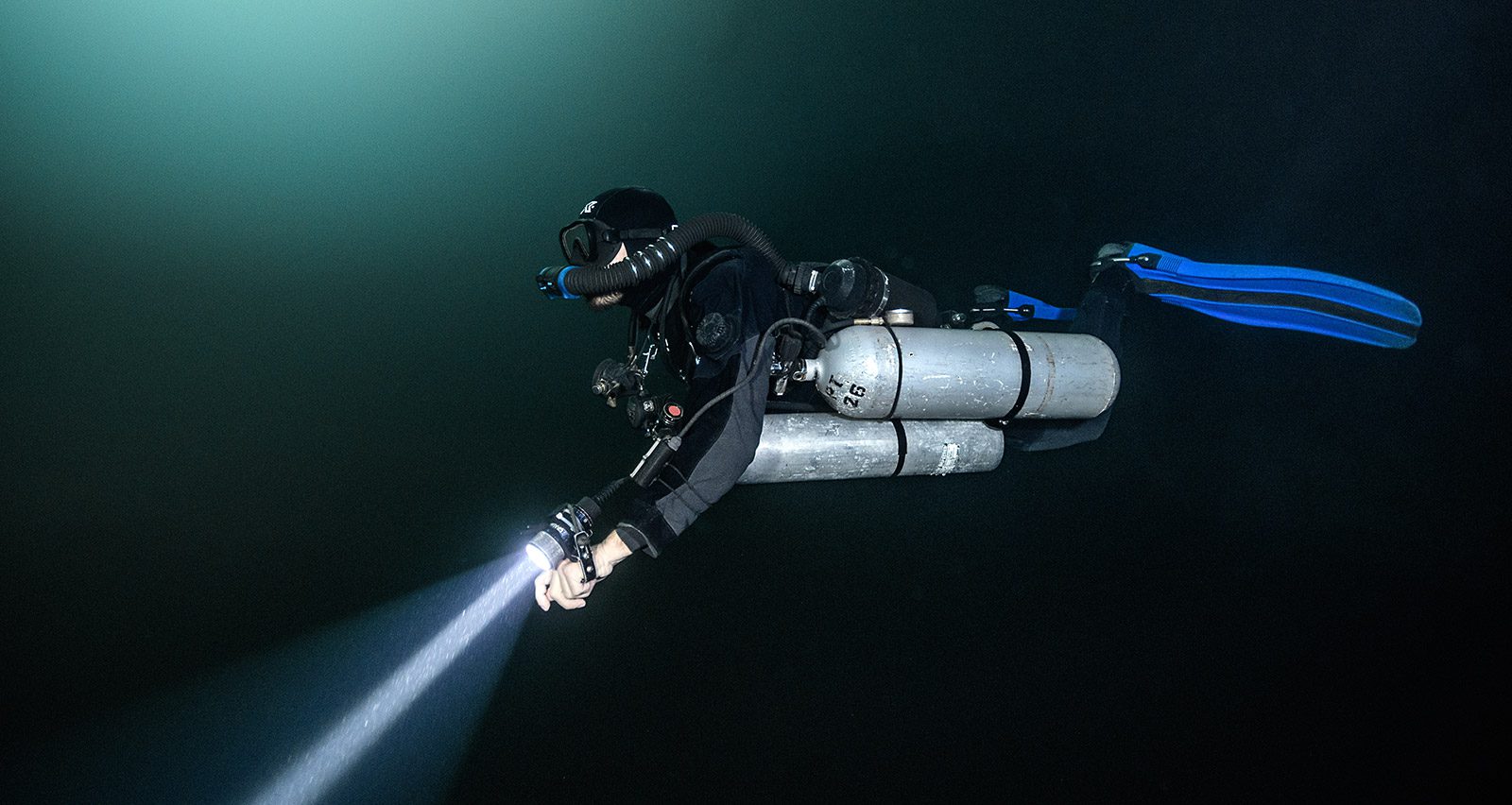
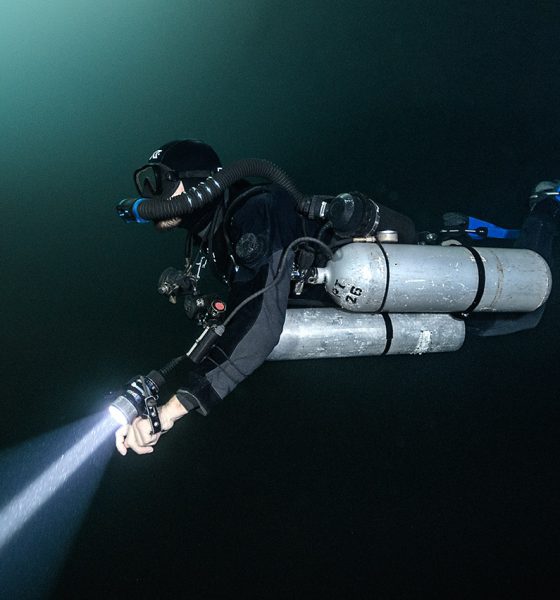
Equipment
Keep It Simple Sidewinder
This month, we continue to explore innovative rebreathers on today’s market with a dive into KISS’s split-canister designed mCCR, the Sidewinder, launched in 2016. Designed to address some of the specific challenges of sidemount rebreathers, the Sidewinder has gained a passionate following among cave divers and explorers, as tech instructors Jake Bulman and Skanda Coffield explain.
By Jake Bulman and Skanda Coffield. Header image: Skanda decompressing in “Cenote The Void”, a deep cave currently under exploration by the team. Photos by Alvaro Herrero at: @mekanphotography unless noted. Full disclosure: Protec Dive Centers owner Patrick Widmann is the KISS Training Director.
Since 1998, KISS Rebreathers has been designing and producing rebreathers known for their simplicity, reliability, and field serviceability. The KISS Classic, designed by the original owner Gordon Smith, has been used by explorers around the world for more than two decades. The Orca Spirit is a lighter back-mounted option from the KISS Classic, and features scrubber design that would later be carried over to the Sidewinder. As the need for a sidemount CCR grew and grew, KISS released the Sidekick. Surrounded by a hard metal shell, this was specifically made for harsh environments. Due to being an independant, self contained unit it could easily be donned/doffed at the surface or underwater, pushed through restrictions, or worn as a bailout rebreather (BOB).
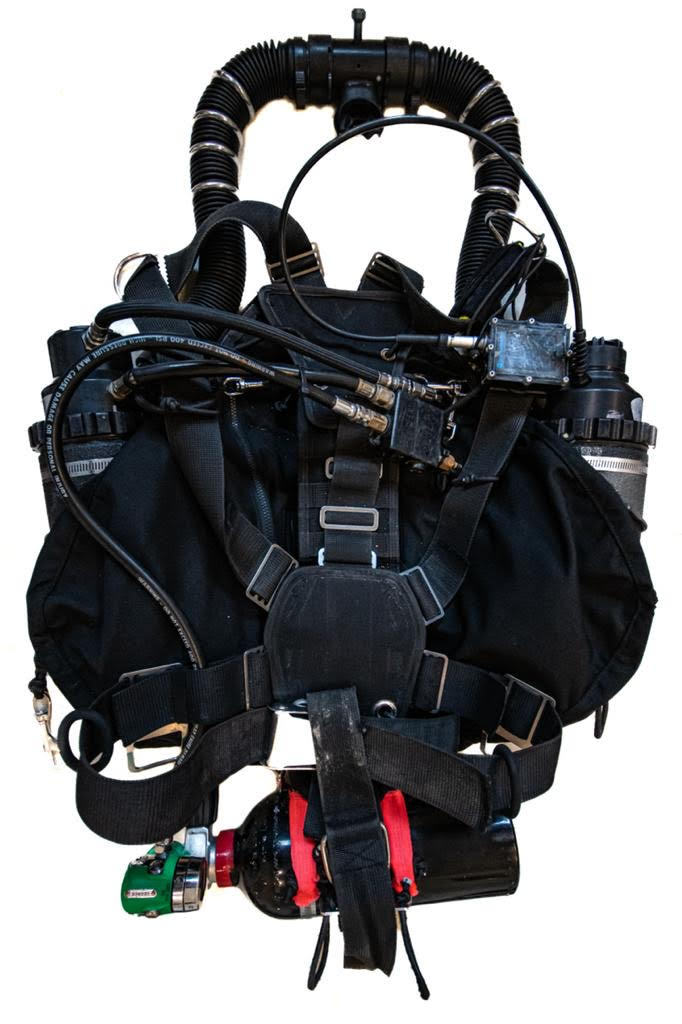
The Sidewinder is unique in that instead of being designed to meet the needs of a specific environment or dive type, fulfilling a specific person’s needs was the goal. Josh Hotaling, a Marine Corporal who lost both his legs in combat, wanted to start using rebreathers for his dives, but the available sidemount rebreathers had changes of balance throughout the breathing cycle due to the counterlung being on one side of the diver. Mike Young, with input from Edd Sorenson, worked on developing a unit that would be balanced while still being light, small and reliable. In 2016, the Sidewinder was born.
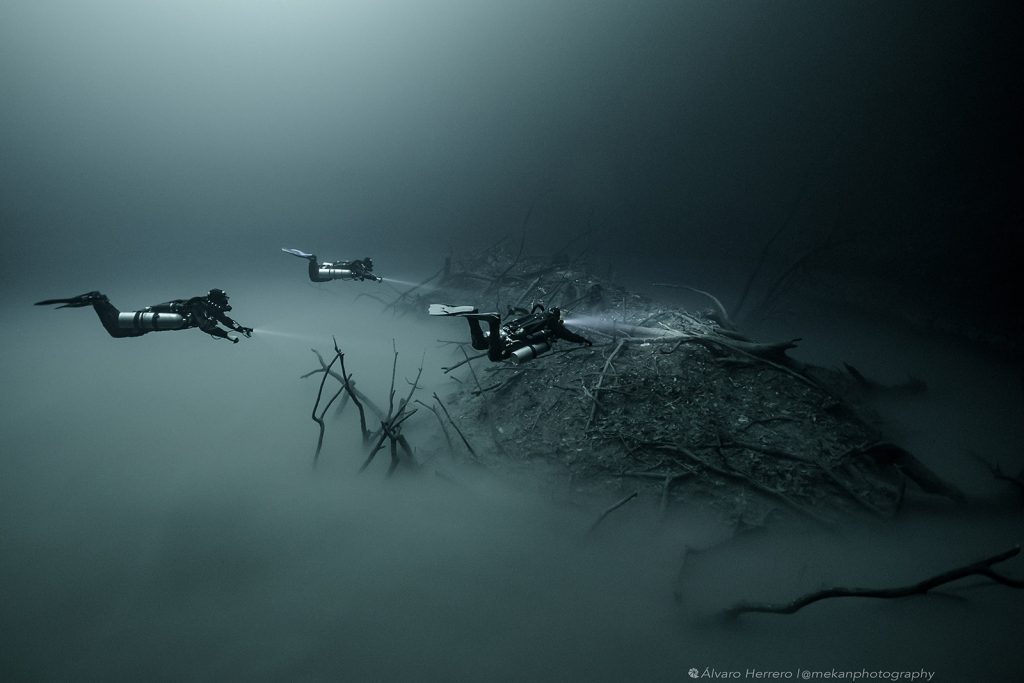
Our first real exposure to the Sidewinder came after Phillip Lehman of the Dominican Republic Speleological Society bought one and trained with Edd Sorenson in Florida. Between the two of us, we had previously owned, dove or been instructors on several units, including JJs, Sidekicks and Pelagians. While all of them have some nice features, they also have their downsides. Either they were very heavy, making buoyancy significantly more difficult (particularly in the shallow caves of Mexico), too large for the size of the caves we aimed to explore, or suffered from other issues. Small restrictions, cenote entrances that are difficult or impossible in backmount, and logistics of reaching some of the cenotes in the first place, meant we needed a sidemount rebreather.
Sidemounted CCRs in a Pre-Sidewinder World
At the time, sidemount rebreathers had two principal drawbacks: While each unit has taken a different approach, and sometimes solved one, a solution to both that doesn’t introduce new problems has proven difficult.
First of all, these rebreathers replace one of the sidemount tanks, giving divers the vertical profile of a standard sidemount configuration while they carry one bailout tank (which serves as diluent for most of them as well). This not only causes redundancy problems in the case of equipment failure on that tank, but also bail out range problems. Many people move to a rebreather to do bigger dives than they can on open circuit, and one bailout tank does not get you very far. Additional bailout tanks can be worn as stages, but this creates a larger vertical profile, significantly diminishing one of the main benefits of sidemount rebreathers. Stages can of course be removed, pushed through restrictions and put on again but it adds significant time and effort to passing through each restriction.
The second major drawback of sidemounted rebreathers has to do with the movement of gas during the breathing cycle. When divers exhale, the gas moves into the counterlung which is inside the rebreather on either the left or right side of the diver. This creates a shift in lateral trim that, while manageable, undoubtedly adds some level of task loading, even if it is subconscious.

On the Sidewinder, unlike other sidemounted units, the scrubber is split into two canisters that allows them to sit alongside divers’ bodies, on top of the two standard sidemount tanks. Problem one, bailout placement and redundancy, solved. In this position, the canisters slightly add to a diver’s profile, but it is hardly noticeable. In fact, in many photos it can even be hard to see that a diver is wearing a rebreather at all, with only the loop giving it away.
Having two scrubber canisters also provides a level of redundancy regarding CO2 management. Scrubbers, designed to “scrub” the CO2 from the gas, can allow CO2 to pass through them for various reasons including packing errors, water, or overuse. Having two helps to reduce the likelihood of most causes of excess CO2.
The counterlung, which sits on the divers back and connects the two absorbent canisters, is the next critical piece to the puzzle. By being so close to the position of the diver’s lungs, the change in trim throughout the breathing cycle is negligible. This difference cannot be overstated enough. Regardless of how comfortable one becomes with the shifting of gas on other side-mounted rebreathers, it will always use some level of attention and energy to compensate for that shift. This is most clearly noticed in the performance of entry-level rebreather divers. Problem two, lateral trim, solved.
The List Goes On
The Sidewinder is one of the lightest rebreathers on the market. [Ed. The Sidewinder is 12.3kg/27.1 lbs., which is lighter than the Liberty SM 22kg/48.5 lbs., but heavier than the RBK 8.62 kg/19 lbs., which is the lightest on the market] This can be a real consideration for divers with back or shoulder injuries, or who need to transport the unit long distances, across difficult terrain or through dry caves. Like open circuit (OC) sidemount, the tanks can also be carried to the water separately. The rebreather can be carried in a single bag, whether for jungle hiking or taking your carry-on luggage during air travel making it very nice to travel internationally with!
Once in the water, the other advantage of a lightweight rebreather becomes apparent. The heavier the unit, the more gas is required to offset that weight. Sometimes this can be done with thicker undergarments or lighter tanks, but this is not always possible. When changing depths, managing buoyancy requires constant adjustments due to the compression or expansion of gas. With lots of gas between the three gas spaces (wing, dry suit, and CCR) the change in buoyancy happens very quickly.
The Sidewinder is incredibly comfortable and easy to dive because of the drastically reduced gas needed to offset the weight. This gives the diver more time to react before the ascent/descent speed starts to pick up. With buoyancy not being a constant struggle to maintain (especially in shallow and constantly changing cave profiles), divers are able to devote more of their focus to monitoring themselves, their team and their surroundings, allowing for greater awareness.
The Sidewinder is a mechanical rebreather, meaning that the oxygen is added via a constant mass flow orifice rather than an electronically controlled solenoid. Constant mass flow works via a combination of a small orifice and a fixed IP (internal pressure) first stage. Unlike a normal first stage that compensates for depth by increasing the IP during descent, the fixed IP first stage remains constant regardless of depth.
If a diver descends to the depth where ambient pressure is equal to that of the first stage, the flow stops, and the manual add button will not add anything. This creates a depth limit, usually 80-90 m/260-300 ft. The flow of oxygen at shallower depths is matched to the amount metabolized by the diver, which maintains the PO2 in the loop, and makes buoyancy much easier. This shifts more control of the rebreather to the diver and removes potential failure points when compared with electronic rebreathers (eCCR) which use a solenoid to automatically add oxygen, when needed to maintain PO2.
Solenoids can be frustrating due to unfortunately timed injections changing a diver’s buoyancy; hence many technical divers will opt to run the rebreather manually to avoid this. Manually running a rebreather requires practice, and increases task loading. That being said, electronic rebreathers do have a place, and several reliable, proven machines exist on the market. This is a personal choice.
The Sidewinder handles water quite well. While water cannot be removed from the unit while diving, it continues working even with substantial water inside. Not only does the diver have two canisters, but the counterlung lies between them and acts as a water trap. It is not uncommon to find water in the bottom of a counterlung if they had water ingress, but the inhalation canister will be dry except in the worst of floods.
If absorbent is fully flooded, there will not be enough contact with the gas to react with it and remove the CO2. However if the sorb gets wet, then water is allowed to move out of the canister, and the sorb will continue working to a certain extent.
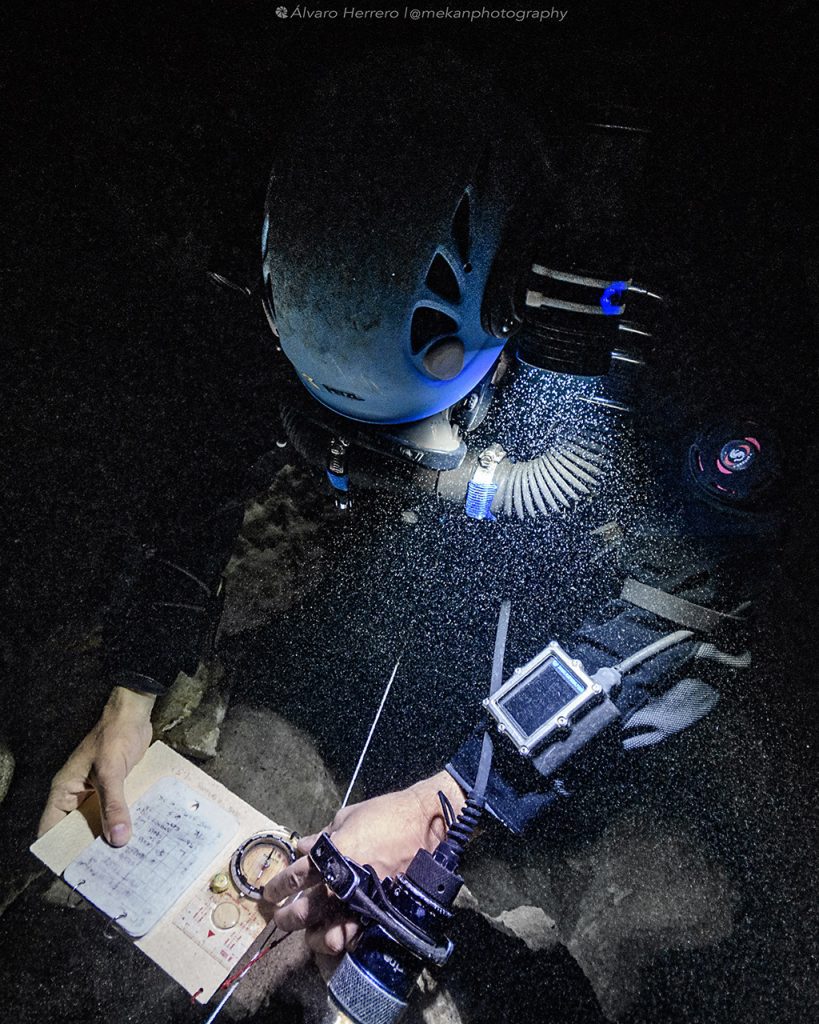
Who is Using the Sidewinder and Why?
Historically, rebreathers were used by people who needed them for a given complex dive or lengthy project, in spite of the extra cost, serviceability, hassle, bulkiness, difficulty, and risks involved. If rebreathers were not needed, they were not used. The Sidewinder was not much different in this regard, with almost all of the early users being cave divers or explorers. However, as many of these barriers have been either removed or reduced, many divers have begun using them, not because they need to, but because they want to.
Cost: Sidemounted rebreathers are generally smaller, and in the case of KISS units, do not feature expensive electronics. This has brought cost to nearly half of what some of the mainstream back-mounted units cost, making it feasible for a much larger audience.
Serviceability: Just like open circuit regulators, rebreathers do require maintenance and servicing. In general, more complex and complicated equipment is more difficult to service yourself , should you even want to. Many eCCRs require that the electronics be sent to the factory or authorised service centre if repairs are needed. The Sidewinder is incredibly simple, it has few parts, and it does not require specialised tools to service (except the orifice tool). The servicing of the unit involves replacing o-rings and not much else! This is great for divers who want to service their own gear or who live far away from someone who services technical dive equipment. Also, during remote expeditions, the rebreather can be serviced without time delays.
Hassle: Setup and breakdown of the Sidewinder is quick and easy, requiring as little as 10 minutes each way for experienced users. It does not require altering your sidemount setup, grabbing different tanks, or accessing a bench in order to put one on. For people who do not need it, this goes a long way towards making it something they want to do.
Bulkiness: Larger rebreathers are often wider than some of the smaller framed divers, and nearly as heavy. Nobody likes carrying heavy equipment around, so the lighter it is, the better. We often find ourselves talking with other divers in the parking lot while in our suits and rebreathers which would definitely not happen with heavier equipment.
Difficulty: From setup to disassembly, and all the diving in between, the sidewinder is extremely comfortable and easy to use. This only gets more pronounced as you put more time into it. The days of first time rebreather tryouts being a difficult, frustrating experience are behind us, and it will only get easier.
Risks: Rebreathers will always come with risks, and that does not change between units. In the past, people accepted the risks because risk was required for their particular dives; however, accepting the risks because one wants to dive is perfectly valid as well. As long as the risks are fully understood—which can only be managed through high quality training—each diver can make their own decision. The vast majority of risks taken in life are for things we want to do, not that we need to do.
Due to these differences, divers of all backgrounds are dipping their toes into rebreather diving, with many deciding it’s something they want to do after they try it. For anyone who previously thought CCR diving took too much time and cost too much money—for instance, people who struggled to carry heavier units, divers wanting to have close encounters with marine life, photographers needing the time to shoot their perfect image without bubbles, instructors without a lot of time to set up their units, or divers on vacation wanting to spend it relaxing—rebreathers are suddenly not only feasible, but desirable.
That being said, there is still a community of hardcore cave explorers utiliizing the Sidewinder. People have experimented with using one in a dual-ccr setup; although, to our knowledge, this has not been put into practice yet in any significant way. A Sidewinder does fit the bill for that purpose however, and can be easily fit with a back mounted unit or a “tube style” sidemount rebreather. We imagine in the coming years we will see this on some of the bigger projects around the world.
How Our Diving has Changed
Our team has been using rebreathers for exploration for quite some time now. But we would never have gone through the effort of using one unless necessary. That was mainly because it took more time to set up and breakdown, was less comfortable, required more equipment, and limited where we could access compared to sidemount OC. The idea of the rebreather being the rule instead of the exception was unimaginable, especially considering a majority of the diving here in Mexico is shallow.
Yet, you will almost always find us diving the rebreather regardless of what we are doing. It no longer takes extra time, adds difficulty to the dive or runs the risk of expensive repair costs. It feels natural. And makes dives more fun!
No longer are we tourists in an alien environment relying on equipment that shifts our balance each time we take a breath. Nor do we need to sacrifice comfort and freedom of movement to extend our limits. With the Sidewinder, we feel like locals, completely adapted to the environment around us and free to move about as we like. The limiting factor is now the diver, not the equipment.
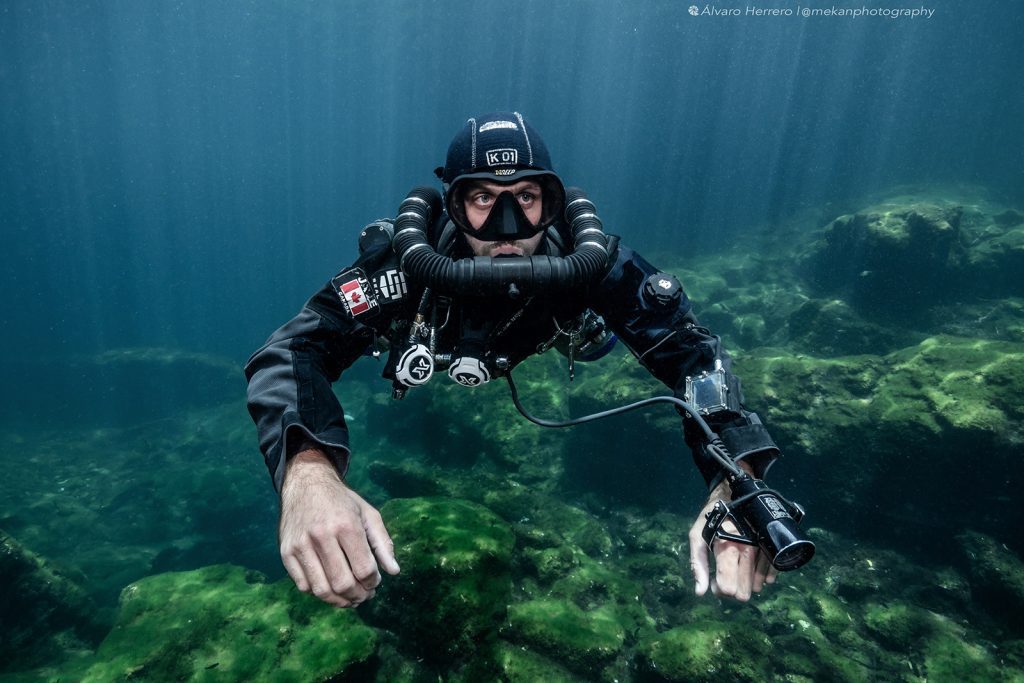
The Sidewinder has Changed Our Game
The Sidewinder is incredibly easy to use. It not only creates an enjoyable experience, but contributes to safety. The level of awareness, understanding of the unit, control and stability that can be seen in entry level divers is shocking. After a few minutes of swimming around in a tryout, first time CCR divers could often be mistaken for highly experienced rebreather divers based on their buoyancy and control in the water. The simplicity of the unit regarding design and “diveability” has allowed us to spend more time training people to be safe, competent divers who truly understand their rebreathers, as well as the risks that come with them and how to manage those risks..
Training aside, it has also changed the game when it comes to exploration in caves around the world, which has led to some truly epic discoveries, but that is a story for another day!
Dive Deeper
Sidemount Pros: KISS Sidewinder 100 Hours In
Website: KISS Rebreathers
InDEPTH: My Journey Into Sidemount Rebreathers by Becky Kagan Schott
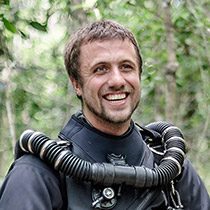
Originally from Canada, Jake Bulman is a full-time cave diving and CCR instructor at Protec Dive Centers in Mexico. The last several years of teaching have been almost exclusively sidewinder focused, from try dives to CCR Cave classes, 4C to 24C, and in several countries around the world. Outside of work, he can be found on exploration projects in local caves of a wide range of depths, distances, and sizes.

Since 2016 Skanda Cophield has been living in Mexico, working at ProTec Dive Centers. Originally from Australia, he made the move to be close to the longest underwater cave systems in the world. When not teaching cave diving or training new sidewinder divers, he spends his time diving his Sidewinder and exploring new and old cave systems.



















